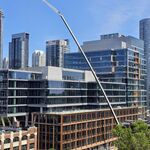Rainforest
Senior Member
Maybe someone with a better calculator than mine can calculate for us. What is the elapsed time between platforms spaced a typical distance apart for a Flexity tram that accelerates to a top speed of 80 km/h versus a top speed of 50-60 km/h ?
My bet is - maybe a few seconds' difference.
The issue for the Crosstown is not whether the trams move quickly. The issue is how much the traffic signalling will delay them. And how much of that type of delay is placed in the schedule.
- Paul
Depends on the acceptable acceleration .. if we assume 0.2 g (= 2 m/s^^2), then:
80 kph = 22.2 m/s, can be reached in 11.1 s
60 kph = 16.7 m/s, can be reached in 8.4 s




